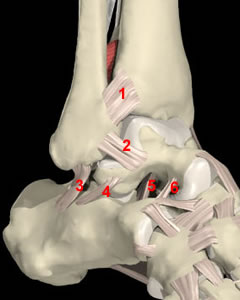Sinus Tarsi Syndrome: Difference between revisions
No edit summary |
No edit summary |
||
| Line 28: | Line 28: | ||
== Epidemiology /Etiology == | == Epidemiology /Etiology == | ||
Mostly the sinus tarsi syndrome occurs after a traumatic lateral ankle sprain. The ligaments of the sinus tarsi can be sprained or torn, and an inflammation and hemorrhage of the synovial recess in the sinus tarsi can occur. This happens in 70% of the cases.<ref name="Taillard et al" /><ref name="Helgeson et al" /><ref name="Nyska and Mann" /> | Mostly the sinus tarsi syndrome occurs after a traumatic lateral ankle sprain. The ligaments of the sinus tarsi can be sprained or torn, and an inflammation and hemorrhage of the synovial recess in the sinus tarsi can occur. This happens in 70% of the cases.<ref name="Taillard et al" /><ref name="Helgeson et al" /><ref name="Nyska and Mann" /> | ||
The sinus tarsi syndrome can also occur as a compression injury, for example to people who have flat or pronated feet. The talus and calcaneus are pressed together as a result of the deformation. This causes bone to bone contact of the talus and calcaneus, with inflammation or arthritis in the sinus.<ref name="Taillard et al" /><ref name="Nyska and Mann" /> | |||
== Characteristics/Clinical Presentation == | == Characteristics/Clinical Presentation == | ||
Revision as of 22:39, 27 December 2010
Original Editors - Merlin Roggeman
Lead Editors - Your name will be added here if you are a lead editor on this page. Read more.
Search Strategy[edit | edit source]
To search for information you can use databases such as PubMed, Web of Science, PEDro or Google Scholar. Use keywords as ‘sinus tarsi syndrome’ or ‘sinus tarsitis’. For specific information you can use ‘AND’ and add ‘physical therapy’, ‘characteristics’, ‘definition’, depending on what you search. Also choose articles from which the full text is available for free.
Definition/Description[edit | edit source]
The sinus tarsi syndrome is a foot pathology, mostly following after a traumatic injury to the ankle. It may also occur if the person has a pes planus or an (over)-pronated foot, which can cause compression in the sinus tarsi. Some characteristics are pain at the lateral side of the ankle and a feeling of instability. [1][2]
Clinically Relevant Anatomy[edit | edit source]
The sinus tarsi is a tunnel between the talus and the calcaneus, which contains some anatomic structures that can be injured in STS. Some ligaments founding this region are the interosseus talo-calcaneal ligament (number 5 in figure 1), the cervical ligament (number 6 in figure 1), and the medial, lateral and intermediate roots of the inferior extensor retinaculum.[1][2][3][4]
The sural nerve passes the sinus tarsi laterally, and some branches of it may run through the tarsi.[4]
Figure 1: an image of the ankle, with the sinus tarsi between the talus and calcaneus, and the ligaments in the sinus (numbers 5 and 6) (source: http://www.blackburnfeet.org.uk/hyperbook/trauma/ankleFx/ankleFxBasic1.htm)
Epidemiology /Etiology[edit | edit source]
Mostly the sinus tarsi syndrome occurs after a traumatic lateral ankle sprain. The ligaments of the sinus tarsi can be sprained or torn, and an inflammation and hemorrhage of the synovial recess in the sinus tarsi can occur. This happens in 70% of the cases.[1][2][4]
The sinus tarsi syndrome can also occur as a compression injury, for example to people who have flat or pronated feet. The talus and calcaneus are pressed together as a result of the deformation. This causes bone to bone contact of the talus and calcaneus, with inflammation or arthritis in the sinus.[1][4]
Characteristics/Clinical Presentation[edit | edit source]
add text here
Differential Diagnosis[edit | edit source]
add text here
Diagnostic Procedures[edit | edit source]
add text here related to medical diagnostic procedures
Outcome Measures[edit | edit source]
add links to outcome measures here (also see Outcome Measures Database)
Examination[edit | edit source]
add text here related to physical examination and assessment
Medical Management
[edit | edit source]
add text here
Physical Therapy Management
[edit | edit source]
add text here
Key Research[edit | edit source]
add links and reviews of high quality evidence here (case studies should be added on new pages using the case study template)
Resources
[edit | edit source]
add appropriate resources here
Clinical Bottom Line[edit | edit source]
add text here
Recent Related Research (from Pubmed)[edit | edit source]
see tutorial on Adding PubMed Feed
Extension:RSS -- Error: Not a valid URL: Feed goes here!!|charset=UTF-8|short|max=10
References[edit | edit source]
see adding references tutorial.
- ↑ 1.0 1.1 1.2 1.3 Taillard W, Meyer JM, Garcia J, Blanc Y. The Sinus Tarsi Syndrome. International Orthopaedics (SICOT) 1981; 5:117-130
- ↑ 2.0 2.1 2.2 Helgeson K. Examination and Intervention for Sinus Tarsi Syndrome. North American Journal of Sports Physical Therapy 2009 February; 4(1):29-37
- ↑ Rosenberg ZS, Beltran J, Bencardino JT. From the RSNA Refrecher Courses. MR Imaging of the Ankle and Foot. RadioGraphics 2000; 20:153-179
- ↑ 4.0 4.1 4.2 4.3 Meir Nyska, Gideon Mann, editors. The unstable ankle. Chapter 14: Sinus Tarsi Syndrome. United States: Human Kinetics Publishers, Inc. 2002. p144-120







